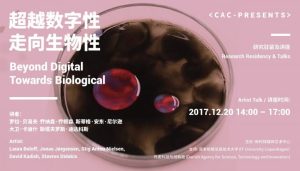Research Residency & Talks | BDTB:Beyond Digital – Towards Biological

Research Residency & Artist Talks
BDTB:Beyond Digital – Towards Biological
Artists:
Laura Beloff
Jonas Jørgensen
Stig Anton Nielsen
David Kadish
Stavros Didakis
Residency: 2017.12.12 – 12.20
Artist Talks: 2017.12.20 (Wednesday), 14.00 – 17.00
Language: English (with Chinese interpreting)
Venue: Chronus Art Center (No.18, No.50 Mo Gan Shan Rd, Shanghai)
Organized by Chronus Art Center
Supported by IT University Copenhagen & Danish Agency for Science, Technology and Innovation
Beyond Digital: Towards Biological (BDTB) will form a network for developing a research framework for techno-organic practice in crossing of the two faculties’ expertise in the arts and the sciences and foster potential for radical innovation and public engagement. Where previously technology has often been defined and developed in contrast to the natural world, newer technologies are increasingly reshaping the boundaries between the technological and the organic. A new wave of innovations is emerging at the intersection of digital technology and the organic matter; from environmental sensing and bio-IT-technologies to synthetic biology, and to algae-generated energy.
During the short residency, BDTB-researchers work closely with CAC Lab to experiment and explore the boundaries between different concepts of life – from artificial chemical life, to biological life, and computational life in silico. These experiments include a hanging small-scale robot that presents computational life, which nurtures and maintains the artificial chemical life evolving in petri-dishes. Another experiment will investigate the relation between biological living organisms, plants, and soft-robotic elements that embody life-like qualities on the scale of humans and animals. These experiments constitute an installation as a proto-environment that presents one type of hybrid ecology, which includes various living and non-living actors. The research and practice of BDTB seek to question different taxonomies of life, both artificial and natural. Through the installation, the researchers enable conditions for a wide spectrum of life-forms to assemble into novel configurations with unique and emergent dynamics.


1.Design of Nature
The merger of technology and biological matter is currently evolving in many different levels. The dichotomy between biological and technological is shifting boundaries and there is no longer a clear division between things, which emerge from nature, and things that are designed by humans. Design and engineering principles and methods are increasingly appearing into a growing number of areas, e.g. due to possibilities to manipulate and modify biological matter. It is becoming obvious that the natural world is increasingly based on man-made design, a development that changes our relation and perception of nature, as well as our understanding of the concept of real. Beloff’s research sees that this development is leading to the construction of uncanny nature; a concept based on the M. Mori’s idea of “uncanny valley”. Where Mori was investigating robots and their human-likeness, the author points towards possible similar sensations concerning man-made biological organisms. The lecture will address the real and uncanny nature present in art & science works that are located in a liminal space – in between what has been and what will come next.
2.Soft Robot Aesthetics and Materiality
The talk presents ongoing research on the aesthetics, materiality, and ecological potential of soft robots. Jørgensen will give a broad introduction to central aspects of technical soft robotics research and discuss select examples of soft robots in media art. His research identifies different notions of soft materiality and argues that soft robotics as a phenomenon should be seen as giving prominence to the enactive and processual potential of soft matter. Against this background, Jørgensen’s own practice-based research on soft robotic visuality, haptics, and movement will be discussed.
3.Braided Robots – Mixed Substrate Computation
Robots can be defined as entities that based on stimuli from their environment autonomously sense interpret and react. Robots can perform such cognitive tasks through embedded electronics but it is to a high degree necessary for them to make use of their structural bodies as well. Examples demonstrate how computational can be entirely offloaded to the material and structural composition of the robot body. Soft robotics have already demonstrated some capabilities in the area of material computation and cognition, however we propose a novel form of robots entirely constructed from composites of filament material structured in braids.
4.Tomorrow’s Ecologies
Hybrid ecosystems exist in a liminal state. They are not quite ecosystems “as-they-were” and yet the exist, operate, and function as ecosystems. They are modulated by human activity – and in this case, robotic activity – but they are still bound to their former realities. This talk explores the position of robots in these hybrid ecosystems, specifically in relation to ecosystems that produce food, through historical examples and a case study involving the hanging robot that we have developed.
5.Transdimensional Ecosystems & Extended Consciousness
Our current almighty techno-gods have successfully managed to deliver their utopian promises; immediacy, satisfaction, engagement. The manifested reality is now enhanced, augmented, and glitched, offering to the creative mind saturated desires that redefine the limitations of our bodies, consciousness, and imagination. The repercussions have dwelled the core of human existence, reshaping as well our understanding of what Art is, or what it can ultimately become. Examining this transitional phase in Post-Digital China, trends and patterns begin to flourish and reproduce, demonstrating that the artistic exploration is not limited to traditional tools and resources, but spans across electronics, digital media, artificial and evolutionary systems, virtual cyberspaces, as well as organisms, bodies, and cells.